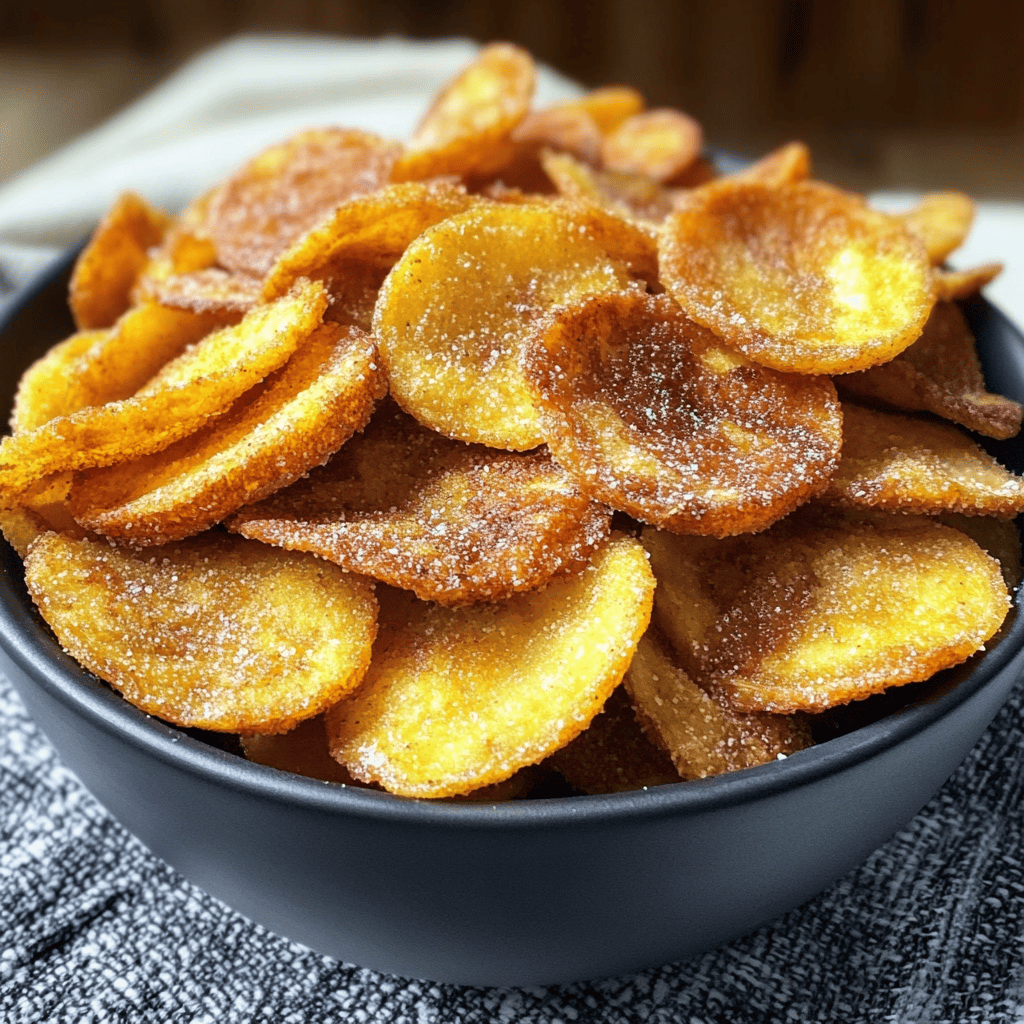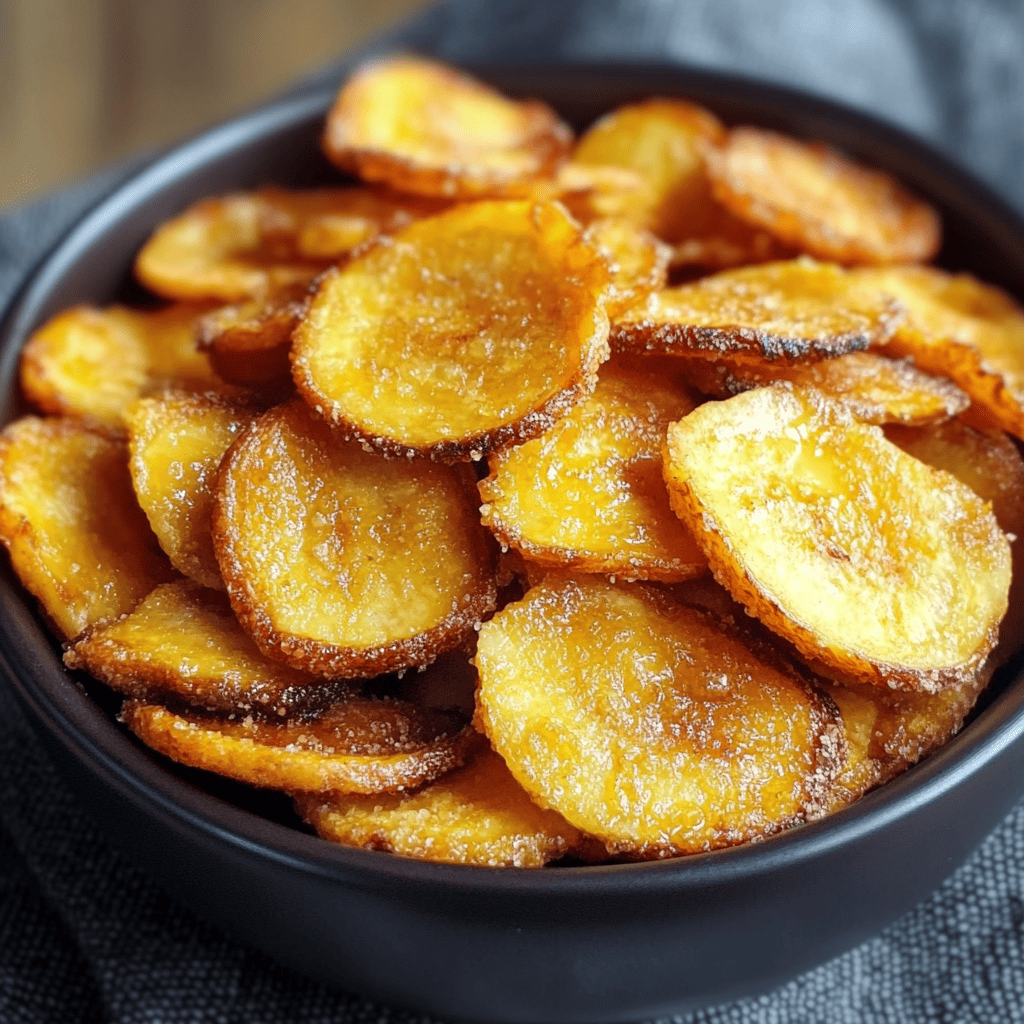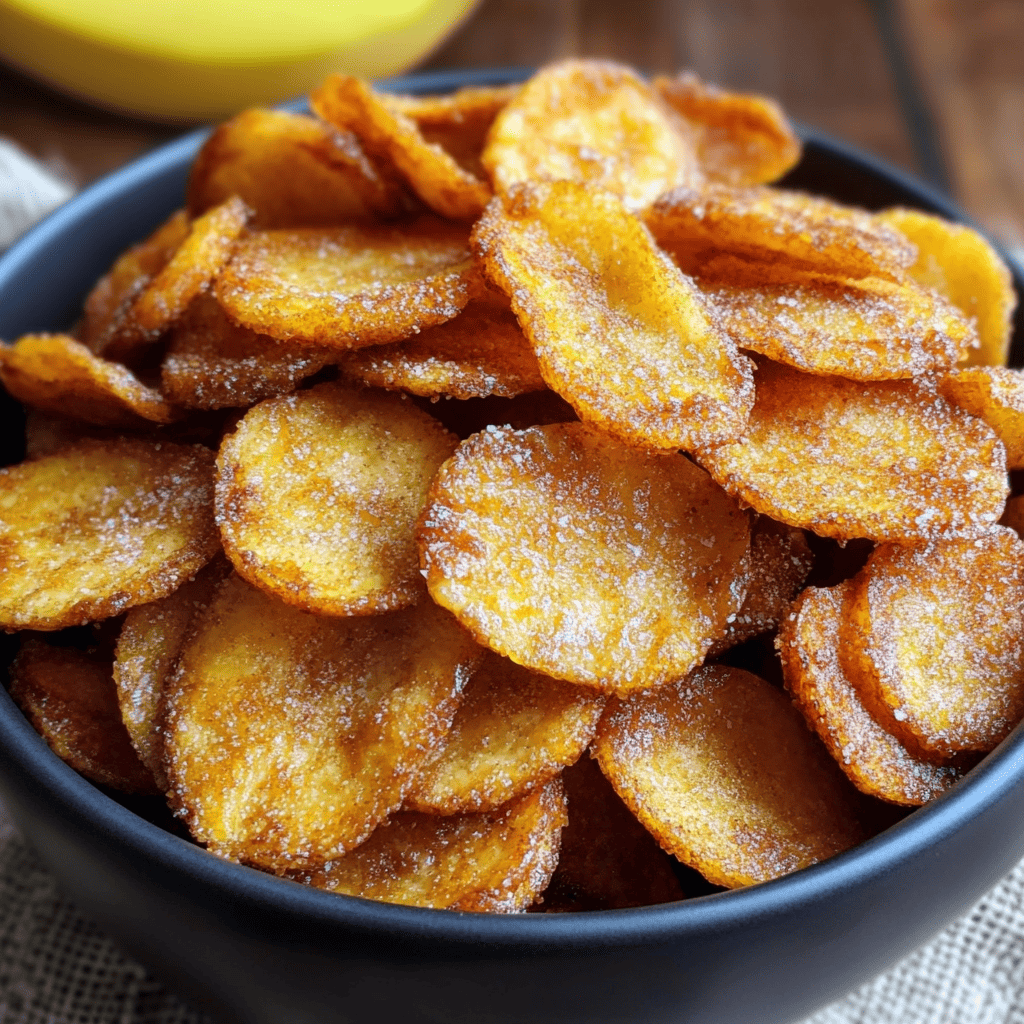Cinnamon Plantain Chips: A Crunchy Snack Full of Flavor and Nutrition
Introduction: A Delicious and Versatile Snack
Cinnamon plantain chips are an irresistible snack that combines the natural sweetness of plantain with the warm, aromatic touch of cinnamon. Easy to prepare and delicious to enjoy anytime, these crunchy slices are a healthy and tasty alternative to traditional potato chips and other processed snacks. Perfect for a sweet tooth, an energy-boosting snack, or even as an original side dish, cinnamon plantain chips conquer palates of all ages. Discover all their secrets!
Detailed History in Spanish: A Crunchy Legacy Through the Centuries
The history of plantain chips is intrinsically linked to that of the banana itself, a fruit with deep roots in human history. Native to Southeast Asia, specifically the region encompassing India, Malaysia, and Indonesia, the plantain (genus Musa ) gradually spread throughout the tropical world thanks to human migration, trade, and exploration.
The first evidence of banana cultivation dates back thousands of years. Archaeological remains found in Papua New Guinea suggest banana cultivation as early as 8000 BC. From its center of origin, the banana traveled westward, reaching Africa around the first century AD, probably introduced by Arab traders.
The arrival of the plantain in Latin America is a crucial chapter in the history of the chips we know today. It was during the era of European colonization, beginning in the 16th century, that Spanish and Portuguese explorers and settlers introduced the plantain to the New World. The favorable climatic conditions of the tropical regions of Latin America and the Caribbean allowed the plantain to quickly adapt and thrive, becoming a staple food in many local cultures.
In these new lands, where the need to preserve food was paramount, various techniques emerged to extend the shelf life of plantains. Sun-drying was an ancient method used by many indigenous cultures to preserve fruits and vegetables. Plantain slices, exposed to the heat of the sun, lost moisture and became a more durable food.
With the advent of new technologies and culinary techniques, frying emerged as another effective method for preserving plantains and, at the same time, transforming them into a crunchy and tasty snack. No single inventor or specific moment can be pinpointed for the birth of “plantain chips” as we know them today. Rather, it was an evolutionary process that likely occurred independently in various tropical regions where plantains were abundant.
In Latin America and the Caribbean, plantain chips, known by a variety of local names that reflect the region’s cultural diversity, have become deeply embedded in culinary traditions. In countries such as Ecuador, Colombia, Venezuela, Costa Rica, Puerto Rico, and Cuba, “chifles,” “mariquitas,” “platanitos,” or “tostones finos” have become an indispensable accompaniment to many traditional dishes, a popular street snack, and an essential element in celebrations and festivities.
Each region developed its own unique characteristics in the preparation and consumption of plantain chips. Some varieties were thinly sliced and fried to a delicate, crunchy texture, while others were slightly coarser and could have a salty or sweet note.
As the world globalized and interest in exotic flavors and natural snacks grew, plantain chips began to transcend the borders of Latin America and the Caribbean. Their unique flavor, which combines the inherent sweetness of plantain with an irresistibly crunchy texture, made them attractive to consumers around the world.
The addition of seasonings such as cinnamon, sugar, salt, and various spices added new dimensions of flavor to this humble snack, further broadening its appeal. The cinnamon version, in particular, offered a comforting, slightly sweet combination that resonated with many palates.
Today, cinnamon plantain chips are a popular snack worldwide, enjoyed by people of all ages and cultures. They can be found in supermarkets, natural food stores, and international markets, in both fried and baked versions, offering a healthier alternative to other processed snacks.
The history of plantain chips is, at its core, a tale of culinary ingenuity, adaptation to local resources, and the delicious transformation of a tropical fruit into a crunchy snack that has taken the world by storm. From humble beginnings as a preservation method to becoming a global snack, cinnamon plantain chips represent a legacy of flavor and tradition that continues to evolve.
More Historical Detail: From Conservation to Global Snack
As we mentioned, the need to preserve plantains was probably the initial driving force behind their transformation into chips. Sun- or fire-drying techniques were ancient methods used in various tropical cultures to extend the fruit’s shelf life. Over time, frying became another popular technique, giving rise to the crispy and tasty chips we know today.
In Latin America and the Caribbean, plantain chips, known by various names such as “chifles,” “mariquitas,” or “platanitos,” have become deeply rooted in local culinary traditions. They have become a common accompaniment to main dishes, a popular street snack, and an essential part of celebrations and festivities.
With globalization and the increased interest in exotic and natural snacks, plantain chips crossed borders. Their unique flavor and crunchy texture made them attractive to consumers around the world, establishing themselves as a versatile snack enjoyed both in their natural form and with various seasonings, including cinnamon, which provides a much-loved sweet and spicy touch.

Ingredients & Detailed Preparation
To prepare these delicious cinnamon plantain chips, you will need the following ingredients:
- Ripe but firm plantains (2 pieces): Just the right ripeness is key to a perfect balance between sweetness and firmness.
- Melted coconut oil (1 tablespoon): Adds a subtle tropical flavor and helps the cinnamon stick. You can also use melted butter for a more traditional touch.
- Ground cinnamon (1 teaspoon): The star ingredient that adds warmth and aroma.
- Sugar (optional, to taste): If you prefer a sweeter touch, you can add a teaspoon of sugar.
Detailed Preparation:
- Preheat the oven: Preheat your oven to 150°C (300°F). Line a baking sheet with parchment paper to prevent the chips from sticking.
- Peel and slice the plantains: Peel the plantains and cut them into thin slices, approximately 2-3 mm thick. Try to make all the slices of similar thickness so they cook evenly.
- Mix the ingredients: In a small bowl, mix the melted coconut oil (or butter) with the cinnamon and sugar (if using).
- Coat the plantain slices: Place the plantain slices in a large bowl. Pour the oil and cinnamon mixture over the slices and toss gently to ensure each slice is well coated.
- Place on the baking sheet: Spread the glazed plantain slices in a single layer on the prepared baking sheet. Avoid overlapping them so they brown evenly.
- Bake: Bake for 15-20 minutes per side, or until the chips are golden brown and crispy. Baking time may vary slightly depending on the thickness of the slices and the power of your oven. Watch them closely to ensure they don’t burn.
- Cool and enjoy: Remove the chips from the oven and let them cool completely on the baking sheet. They’ll become crispier as they cool. And that’s it! You’re ready to enjoy your delicious cinnamon plantain chips.
Additional Tips
- Selecting plantains: Use plantains that are ripe but still firm. Overripe plantains can become mushy and difficult to slice thinly.
- Slice thickness: The thinner the slices, the crispier the chips will be. You can use a mandoline to get even, thin slices.
- Flavor Variations: Experiment by adding other spices like nutmeg, cloves, or a touch of ginger to the oil and cinnamon mixture.
- Baked vs. Fried: If you prefer a more traditional version, you can fry the plantain slices in hot oil until golden brown and crispy. Then, sprinkle with cinnamon and sugar. The baked version is healthier because it reduces the amount of fat.
- Storage: Store cinnamon plantain chips in an airtight container at room temperature for a few days to maintain their freshness and crunch.

Frequently Asked Questions and Estimated Preparation Time
- Can I use green plantains? While you can make chips with green plantains (plantain), the flavor will be less sweet and more starchy. For this cinnamon chips recipe, ripe plantains offer a better balance of flavor.
- How long do chips last? Properly stored in an airtight container, cinnamon plantain chips can last up to a week, although their crunch may diminish slightly over time.
- Are these chips healthy? Compared to commercial potato chips and other processed snacks, baked plantain chips are a healthier option. The plantain provides fiber, potassium, and some vitamins. By baking them instead of frying them, the amount of fat is significantly reduced.
Estimated Preparation Time:
- Preparation: 15 minutes (peel, cut and glaze)
- Cooking: 30-40 minutes (approximately 20 minutes per side)
- Total time: Approximately 45-55 minutes
Texture and Flavor
The texture of these baked cinnamon plantain chips is deliciously crunchy, offering a satisfying bite. As they cool, this crunchiness intensifies. When fried, the texture will be even more crumbly and crispy.
The flavor is a harmonious combination of the natural, tropical sweetness of the ripe plantain, enhanced by the warm, spicy, and slightly sweet notes of cinnamon. Adding sugar will intensify the sweetness, creating an even more indulgent snack. Coconut oil (if used) adds a subtle exotic undertone.
Consumption Context কখন খাবেন কখন খাবেন? কখন খাবেন? কখন খাবেন? কখন খাবেন?
Cinnamon plantain chips are incredibly versatile and adapt to various consumption moments:
- Between-meal snacks: Perfect for satisfying a sweet or savory craving in a healthier way.
- On the go: A practical and energetic snack for school, work, or outdoor activities.
- Accompaniment: They can complement desserts such as ice cream or yogurt, adding a crunchy touch.
- For parties and gatherings: An original and tasty option to offer your guests.
- Breakfast or snack: Ideal with coffee, tea, or a smoothie.
- Creative Topping: You can crush them and use them as a topping for fruit salads or breakfast bowls.
Visual Aspect
Cinnamon plantain chips are visually appealing. They are thin, golden-yellow slices with slightly darker, crispier edges. The sprinkled cinnamon gives them a mottled reddish-brown hue, making them visually appealing. Their round, uniform shape (if sliced carefully) makes them even more appealing.
Curiosities
- Plantain or Banana? In many Spanish-speaking countries, a distinction is made between the “plátano macho” (larger and starchier, used for cooking) and the “banana” (smaller and sweeter, eaten raw). However, in some regions, the two terms are used interchangeably.
- The banana plant is not a tree: Although it looks like a tree because of its size, the banana plant is actually the largest herb in the world.
- Rich in potassium: Bananas are an excellent source of potassium, an important mineral for heart health and muscle function.
- Fiber for digestion: Bananas also provide a good amount of fiber, which is beneficial for digestion and the feeling of satiety.
- Surprising Uses: In some cultures, banana leaves are used as a wrapper for cooking food or as biodegradable plates.
Nutritional Value (Estimated per Serving – 30g)
Please note that these values are estimates and may vary depending on the size of the slices, the amount of oil used, and whether sugar is added.
- Calories: 150-180 kcal
- Fats: 8-10 g (mainly from coconut oil or butter)
- Saturated fat: 6-8 g
- Carbohydrates: 18-22 g
- Sugars: 8-12 g (natural sugars from banana + optional added sugar)
- Fiber: 2-3 g
- Protein: 1-2 g
- Potassium: 250-350 mg (approximately 7-10% of the recommended daily intake)
- Vitamin B6: 0.1-0.2 mg (approximately 5-10% of the recommended daily intake)
Additional Benefits and Interesting Facts
- Quick energy source: The natural carbohydrates in bananas provide a quick and sustained source of energy, ideal for athletes or to combat fatigue.
- Helps prevent cramps: The high potassium content can help prevent muscle cramps, especially after exercise.
- Beneficial for blood pressure: Potassium also plays an important role in regulating blood pressure.
- Improves mood: Bananas contain tryptophan, an amino acid that the body converts into serotonin, a neurotransmitter associated with feelings of well-being and happiness.
- Gluten-free option: Plantain chips are naturally gluten-free, making them a suitable snack for people with gluten sensitivity or celiac disease.
- Versatile in the kitchen: In addition to being a delicious snack on their own, plantain chips can be used in a variety of culinary preparations, providing a sweet and crunchy touch.
Other Information
- Environmental impact: Banana cultivation has an environmental impact that varies depending on the agricultural practices used. It’s preferable to choose sustainably grown or fair trade bananas.
- Banana varieties: There are many varieties of bananas around the world, each with its own unique flavor and texture characteristics. The Cavendish variety is the most commonly marketed internationally.
- Industrial plantain chips: Various brands of pre-made plantain chips are available on the market, often fried and with additives. Making them at home allows you to control the ingredients and the amount of oil and sugar.

Conclusion: A Crunchy Bite That Conquers
Cinnamon plantain chips are much more than a simple snack. They’re a delicious combination of flavor, texture, and some nutritional benefits. Their easy preparation at home allows you to enjoy a crunchy and aromatic snack, tailored to your sweetness and spice preferences. Whether for a sudden craving, an original side dish, or an energy-boosting snack, these chips are a versatile and tasty option that’s sure to win over your palate. Go ahead and prepare them and enjoy this tropical delight with a touch of warm cinnamon!

